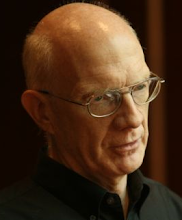I asked my younger daughter (who lives in New York City) what she thought about the new Times Square makeover (where Broadway has been blocked from automobile traffic in a couple of places) and she seemed dismissive. (She might have called it a "gimmick".) I think that she, as an adoptive New Yorker, wants to keep away from touristy areas, and Times Square certainly qualifies.
lives in New York City) what she thought about the new Times Square makeover (where Broadway has been blocked from automobile traffic in a couple of places) and she seemed dismissive. (She might have called it a "gimmick".) I think that she, as an adoptive New Yorker, wants to keep away from touristy areas, and Times Square certainly qualifies.
It's weird to think about cheap folding lawn chairs in the left-over spaces where Broadway used to cross 7th Avenue (which remains open, by the way.) Supposedly, the city takes up the chairs every night and redistributes them every morning. Is this any way to run a national urban landmark?
7th Avenue (which remains open, by the way.) Supposedly, the city takes up the chairs every night and redistributes them every morning. Is this any way to run a national urban landmark?
But there's something important about the New Times Square makeover by the Planning Department of New York City. If nothing else, it's the first U.S. project (ad hoc though it be) in my memory whose momentum is decidedly anti-car. Nicholai Ouroussoff reviews the "design" in this article. Nick O (as I will dare to call him) is right on the money about the unplanned nature of the action (as he says, "this is not the Piazza San Marco in Venice or even Trafalgar Square", but I think it is so important to expose people (even if they are unwitting tourists!) to the idea that the U.S. can have a "public realm" that isn't driven (sorry!) by traffic engineering.
Over at the very interesting blog, World Streets (newly on my blogroll), there is a very interesting article (which promises to be a series) by Paul Barter, a professor in public policy at the National University of Singapore, about "The Battle for Street Space" that is really worth a read (as is much of the other stuff over there.) I see many people from all over the world on that blog talking about 30 kph (yes, kph) speed limits everywhere except on highways. My first reaction is to lecture these people about how this will never fly in the U.S.; the auto is forever king here. But maybe not -- Times Square is a very interesting precedent. It will be fascinating to see where it goes.
 lives in New York City) what she thought about the new Times Square makeover (where Broadway has been blocked from automobile traffic in a couple of places) and she seemed dismissive. (She might have called it a "gimmick".) I think that she, as an adoptive New Yorker, wants to keep away from touristy areas, and Times Square certainly qualifies.
lives in New York City) what she thought about the new Times Square makeover (where Broadway has been blocked from automobile traffic in a couple of places) and she seemed dismissive. (She might have called it a "gimmick".) I think that she, as an adoptive New Yorker, wants to keep away from touristy areas, and Times Square certainly qualifies.It's weird to think about cheap folding lawn chairs in the left-over spaces where Broadway used to cross
 7th Avenue (which remains open, by the way.) Supposedly, the city takes up the chairs every night and redistributes them every morning. Is this any way to run a national urban landmark?
7th Avenue (which remains open, by the way.) Supposedly, the city takes up the chairs every night and redistributes them every morning. Is this any way to run a national urban landmark?But there's something important about the New Times Square makeover by the Planning Department of New York City. If nothing else, it's the first U.S. project (ad hoc though it be) in my memory whose momentum is decidedly anti-car. Nicholai Ouroussoff reviews the "design" in this article. Nick O (as I will dare to call him) is right on the money about the unplanned nature of the action (as he says, "this is not the Piazza San Marco in Venice or even Trafalgar Square", but I think it is so important to expose people (even if they are unwitting tourists!) to the idea that the U.S. can have a "public realm" that isn't driven (sorry!) by traffic engineering.
Over at the very interesting blog, World Streets (newly on my blogroll), there is a very interesting article (which promises to be a series) by Paul Barter, a professor in public policy at the National University of Singapore, about "The Battle for Street Space" that is really worth a read (as is much of the other stuff over there.) I see many people from all over the world on that blog talking about 30 kph (yes, kph) speed limits everywhere except on highways. My first reaction is to lecture these people about how this will never fly in the U.S.; the auto is forever king here. But maybe not -- Times Square is a very interesting precedent. It will be fascinating to see where it goes.





No comments:
Post a Comment